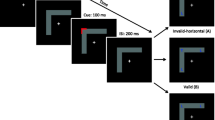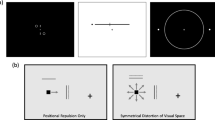Summary
Two experiments investigated relative spatial coding in the Simon effect. It was hypothesized that relative spatial coding is carried out with reference to the position of the focus of visual attention. The spatial code for an imperative stimulus presented exactly at the position of focal attention should be neutral on the horizontal plane, and therefore no Simon effect should be observed. However, when the imperative stimulus is presented to the left or to the right of the current position of focal attention, the spatial code should not be neutral, thus producing a Simon effect. In both experiments, focal attention was manipulated either by a peripherally presented onset precue (Experiment 1) or by a centrally presented symbolic precue (Experiment 2). Results showed that the Simon effect was substantially reduced in both experiments when a valid precue preceded the imperative stimulus just in time to conclude refocusing of attention to the position of the imperative stimulus before it was presented. However, conditions with neutral precues yielded a normally sized Simon effect. In both experiments, the Simon effect decreased as the SOA grew when the precue was valid. At least for the Simon effect, the results can be interpreted as evidence that relative spatial coding is functionally related to the position of the focus of attention.
Similar content being viewed by others
References
Allport, A. (1987). Selection for action: Some behavioral and neuropsychological considerations of attention and action. In H. Heuer & A. F. Sanders (Eds.), Perspectives on perception and action (pp. 395–419). Hillsdale, NJ: Erlbaum.
Arend, K., & Wandmacher, J. (1987). On the generality of logical recoding in spatial interference tasks. Acta Psychologica, 65, 193–210.
Baylis, G., & Driver, J. (1992). Visual parsing and response competition: The effect of grouping factors. Perception & Psychophysics, 51, 145–162.
Castiello, U., & Umiltá, C. (1990). Size of the attentional focus and efficiency of processing. Acta Psychologica, 73, 195–209.
Duncan, J. (1984). Selective attention and the organization of visual information. Journal of Experimental Psychology: General, 113, 501–517.
Eriksen, C. W. & St James, J. D. (1986). Visual attention within and around the field of focal attention: A zoom lens model. Perception & Psychophysics, 40, 225–240.
Fitts, P. M., & Seeger, C. M. (1953). S-R compatibility: Spatial characteristics of stimulus and response codes. Journal of Experimental Psychology, 46, 199–210.
Folk, C. L., Remington, R. W., & Johnston, J. C. (1992). Involuntary covert orienting is contingent on attentional control settings. Journal of Experimental Psychology: Human Perception and Performance, 18, 1030–1044.
Hedge, A., & Marsh, N. W. A. (1975). The effect of irrelevant spatial correspondence on two-choice response time. Acta Psychologica, 39, 427–439.
Heijden, A. H. C. van der (1989). Probability matching in visual selective attention. Canadian Journal of Psychology, 43, 45–52.
Heijden, A. H. C. van der (1992). Selective attention in vision. London: Routledge & Kegan Paul.
Heijden, A. H. C. van der (1993). The role of position in object selection in vision. Psychological Research/Psychologische Forsch, 56, 44–58.
Hommel, B. (1993 a). The role of attention for the Simon effect. Psychological Research, Psychologische Forschung, 56, 208–222.
Hommel, B. (1993 b). The relationship between stimulus processing and response selection on the Simon task: Evidence for a temporal overlap. Psychological Research/Psychologische Forschung, 55, 280–290.
Hommel, B. (1994). Effects of irrelevant spatial S-R compatibility depend on stimulus complexity. Psychological Research/Psychologische Forschung, 56, 179–184.
Jonides, J. (1981). Voluntary versus automatic control over the mind's eye's movement. In J. Long & A. Baddeley (Eds.), Attention and performance IX (pp. 187–203). Hillsdale, NJ: Erlbaum.
Kahneman, D. & Treisman, A. (1984). Changing views of attention and automaticity. In R. Parasureman & D. R. Davies (Eds.), Varieties of attention (pp. 29–61). New York: Academic Press.
Kornblum, S., Hasbroucq, T., & Osman, A. (1990). Dimensional overlap: Cognitive basis for stimulus-response compatibility — A model and a taxonomy. Psychological Review, 97, 253–270.
Lamberts, K., Tavernier, & d'Ydewalle, G. (1992). Effects of multiple reference points in spatial stimulus-response compatibility. Acta Psychologica, 79, 115–130.
Mewaldt, S. P., Connelly, G. L., & Simon, J. R. (1980). Response selection in choice reaction time: Task of a buffer model. Memory & Cognition, 8, 606–611.
Neumann, O. (1983). Über den Zusammenhang zwischen Enge und Selektivität der Aufmerksamkeit. Bochum: Bericht Nr. 19, Pschologisches Institut der Ruhr-Universität Bochum, Arbeitseinheit Kognitionspsychologie.
Neumann, O. (1990). Visual attention and action. In O. Neumann & W. Prinz (Eds.), Relationship between perception and action: Current approaches (pp. 227–267). Berlin: Springer.
Nicoletti, R., & Umiltá, C. (1989). Splitting visual space with attention. Journal of Experimental Psychology: Human Perception and Performance, 15, 164–169.
Nicoletti, R. & Umiltà, C. (1994). Attention shifts produce stimulus spatial codes. Psychological Research/Psychologische Forschung, 56, 144–150.
Posner, M. I. (1980). Orienting of attention. Quarterly Journal of Experimental Psychology, 32, 3–25.
Posner, M. I., Snyder, C. R. R., & Davidson, B. J. (1980). Attention and the detection of signals. Journal of Experimental Psychology: General, 109, 160–174.
Prinz, W. (1990). A common coding approach to perception and action. In O. Neumann & W. Prinz (Eds.), Relationship between perception and action (pp. 167–201). Berlin: Springer.
Proctor, R. W., Lu, C. H., & van Zandt, T. (1992). Enhancement of the Simon effect by response precueing. Acta Psychologica, 81, 53–74.
Proctor, R. W., Reeve, T. G., & van Zandt, T. (1992). Salient-features coding in response selection. In G. Stelmach & J. Requin (Eds.), Tutorials in motor behavior II (pp. 727–741). Amsterdam: North-Holland.
Rafal, R. D., Calabresi, P. A., Brennan, C. W., & Sciolto, T. K. (1989). Saccade preparation inhibits reorienting to recently attended locations. Journal of Experimental Psychology: Human Perception and Performance, 12, 361–369.
Remington, R., & Pierce, L. (1984). Moving attention: Evidence for time-invariant shifts of visual selective attention. Perception & Psychophysics, 35, 393–399.
Riggio, L., Gawryszewski, L., & Umiltà, C. (1986). What is crossed in crossed-hand effects? Acta Psychologica, 62, 89–100.
Rizzolatti, G., Riggio, L., Dascola, I., & Umiltà, C. (1987). Reorienting of attention across the horizontal and vertical meridians: Evidence in favor of a premotor theory of attention. Neuropsychologia, 25, 31–40.
Shulman, G. L., Remington, R. W., & McLean, J. P. (1979). Moving attention through visual space. Journal of Experimental Psychology: Human Perception and Performance, 5, 522–526.
Simon, J. R. (1969). Reaction toward the source of stimulation. Journal of Experimental Psychology, 81, 1974–1976.
Simon, J. R. (1990). The effects of an irrelevant directional cue on human information processing. In R. W. Proctor and T. G. Reeve (Eds.), Stimulus-response compatibility (pp. 31–86). Amsterdam: North-Holland.
Simon, J. R., Acosta, E., Mewaldt, S. P., & Speidel, C. R. (1976). The effect of an irrelevant directional cue on choice reaction time: Duration of the phenomenon and its relation to stages of processing. Perception & Psychophysics, 19, 16–22.
Sokolov, E. (1963). Perception and the conditioned reflex, New York: MacMillan.
Stoffer, T. H. (1991). Attentional focussing and spatial stimulus-response compatibility. Psychological Research, 53, 127–135.
Stoffer, T. H. (1993). The time course of attentional zooming: A comparison of voluntary and involuntary allocation of attention to the levels of compound stimuli. Psychological Research/Psychologische Forschung, 56, 14–25.
Teichner, W. H., & Krebs, M. J. (1974). Laws of visual choice reaction time. Psychological Review, 81, 75–98.
Theeuwes, J. (1991). Exogenous and endogenous control of attention: The effect of visual onsets and offsets. Perception & Psychophysics, 49, 83–90.
Tipper, S. P., Lortie, C., & Baylis, G. C. (1992). Selective reaching: Evidence for action-centered attention. Journal of Experimental Psychology: Human Perception and Performance, 18, 891–905.
Treisman, A. M. (1988). Features and objects: The fourteenth Bartlett memorial lecture. Quarterly Journal of Experimental Psychology, 40A, 201–237.
Treisman, A., & Gelade, G. (1980). A feature-integration theory of attention. Cognitive Psychology, 12, 97–136.
Tsal, Y. (1983). Movements of attention across the visual field. Journal of Experimental Psychology: Human Perception and Performance, 9, 523–530.
Umiltà, C., & Liotti, M. (1987). Egocentric and relative spatial codes in S-R compatibility. Psychological Research, 49, 81–90.
Umiltà, C., & Nicoletti, R. (1985). Attention and coding effects in S-R compatibility due to irrelevant spatial cues. In M. I. Posner & O. S. M. Marin (Eds.), Attention and performance XI (pp. 457–471). Hillsdale, NJ: Erlbaum.
Umiltà, C., & Nicoletti, R. (1990). Spatial stimulus-response compatibility. In R. W. Proctor & T. G. Reeve (Eds.), Stimulus-response compatibility (pp. 89–116). Amsterdam: North-Holland.
Umiltà, C., & Nicoletti, R. (1992) An integrated model of the Simon effect. In J. Alegria, D. Holender, J. Junca de Morais, & M. Radeau (Eds.), Analytic approaches to human cognition (pp. 331–350). Amsterdam: Elsevier.
Verfaellie, M., Bowers, D., & Heilman, K. M. (1988). Attentional factors in the occurrence of stimulus-response compatibility effects. Neuropsychologia, 26, 435–444.
Verfaellie, M., Bowers, D., & Heilman, K. M. (1990). Attentional processes in spatial stimulus-response compatibility. In R. W. Proctor & T. G. Reeve (Eds.), Stimulus-response compatibility (pp. 261–275). Amsterdam: North-Holland.
Wallace, R. J. (1971). S-R compatibility and the idea of a response code. Journal of Experimental Psychology, 88, 354–360.
Warner, C. B., Juola, J. F., & Koshino, H. (1990). Voluntary allocation versus automatic capture of visual attention. Perception & Psychophysics, 48, 243–251.
Yantis, S., & Jonides, J. (1990). Abrupt visual onsets and selective attention: Voluntary versus automatic allocation. Journal of Experimental Psychology: Human Perception and Performance, 16, 121–134.
Author information
Authors and Affiliations
Corresponding author
Rights and permissions
About this article
Cite this article
Stoffer, T.H., Yakin, A.R. The functional role of attention for spatial coding in the Simon effect. Psychol. Res 56, 151–162 (1994). https://doi.org/10.1007/BF00419702
Issue Date:
DOI: https://doi.org/10.1007/BF00419702




